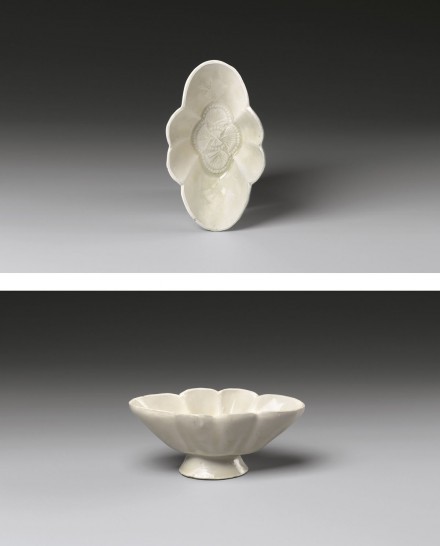J.J. Lally & Co., Oriental Art / New York City, New York
MenuPast Exhibition
Chinese Ceramics in Black and White
March 20–April 10, 2010

12.
AN INSCRIBED WHITE PORCELAIN WINE CUP
Tang Dynasty, A.D. 9th–early 10th Century
following a silver prototype, the delicate cup with steeply rounded sides divided into six unequal lobes, with four smaller lobes opposed at the center and two larger lobes at the long ends, creating an oval flower-shaped outline, the upturned rim with knife-pared lip, the base of the cup decorated on the interior with an impressed foliate motif comprised of fan-shaped bundles of stamens ending in rows of dotted anthers, and with similar motifs lightly moulded on the interior of the two larger lobes, the exterior plain, resting on a high oval foot with flaring sides, covered all over with a transparent glaze of very pale yellowish tone continuing over the underside of the foot, the rim of the foot wiped clean of glaze revealing the fine white porcelain body, the recessed base inscribed with the character ying cut through the glaze before firing.
Length 41⁄4 inches (10.8 cm)
Recent scholarship indicates that Tang dynasty white porcelains inscribed with the character ying were produced exclusively for imperial use. Wang Chanqi discusses this rare category of porcelains in “White Porcelains with Chinese Character Ying from the Qinglongsi Temple Site” in Kaogu yu wenwu, 1997, no. 6, pp. 6–12, analyzing a group of porcelains bearing the character ying which were excavated in 1992 in Xi’an, Shaanxi province at the site of the Qinglong Buddhist temple which enjoyed imperial patronage during the Tang dynasty. Wang concludes that porcelains inscribed with the character ying were reserved exclusively for the use of the emperor and were marked “ying” for the imperial treasury called the “Da Ying Ku” (which may be translated as “Storeroom of Great Abundance”). The Da Ying Ku is mentioned in Tang historical texts as the largest and most important of all the palace storerooms during the Tang dynasty. The ying marked porcelains discovered at the Qinglongsi site were most likely given to the temple as pious gifts directly from the emperor.
Another Chinese scholar, Zhi Guangzheng, in “Tang dai Xingyao gongci ‘ying’ zi yanjiu” (A Study of Tang Dynasty Xing Ware Tribute Porcelains Marked with the Character “Ying”), published by Zhang Zhizhong et. al. (ed.s) in Xingyao yanjiu (Xing Kiln Research), Beijing, 2007, pp. 474–480, states that white porcelains from the Xing kilns in Hebei province first became imperial tribute wares in the Tianbo era (A.D. 742–756) and continued to be used as imperial tribute ware through the end of the Tang dynasty.
The distinctive lobed oval shape of this cup derives from Sasanian silver prototypes introduced to Tang China via the ‘Silk Road.’ Several Sasanian silver footed wine cups of closely related form are illustrated by Gyllensvärd in line drawings in “T’ang Gold and Silver,” B.M.F.E.A. Bulletin no. 29, Stockholm, 1957, fig. 20. Gyllensvärd also points out that lobed cups following Sasanian forms were produced in pottery and porcelain in the Tang dynasty and illustrates in another line drawing the white porcelain lobed cup from the Kempe Collection, ibid, fig. 20:d.
A Xingyao white porcelain lobed cup on high foot, inscribed with the character “guan” on the base, excavated in 1978 at Linan county, Zhejiang province from the tomb of Qian Kuan, dated A.D. 900, is illustrated in Zhongguo chutu ciqi quanji (9) Zhejiang (Complete Collection of Ceramic Art Unearthed in China, Vol. 9, Zhejiang Province), Beijing, 2008, p. 105, no. 105. Another Xingyao white porcelain lobed cup on high foot, also with a “guan” character incised on the base, excavated in 1980 from the tomb of Qian Kuan’s wife is illustrated in Zhongguo taoci quanji (5) Sui Tang (The Complete Works of Chinese Ceramics, Vol. 5, Sui and Tang), Shanghai, 2000, p. 163, no. 172.
唐 「盈」字款白瓷多曲長盃 長 10.8 厘米
12.
AN INSCRIBED WHITE PORCELAIN WINE CUP
Tang Dynasty, A.D. 9th–early 10th Century
Length 41⁄4 inches (10.8 cm)